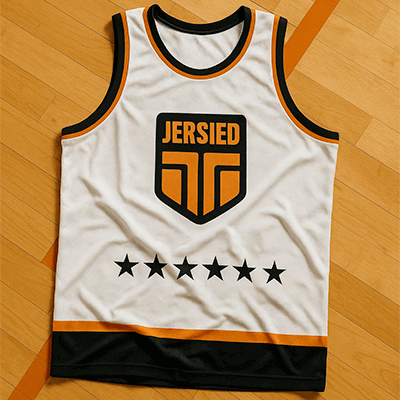
Basketball Uniform Regulations: What's Legal for Different Leagues
Basketball uniform regulations vary significantly across different leagues and levels of play. Understanding these requirements ensures your team meets all legal standards while maximizing performance and team identity. From high school NFHS rules to NCAA regulations and recreational league guidelines, each governing body has specific uniform requirements.
What are the high school basketball uniform rules?
High school basketball uniform rules require jerseys to be single-colored with contrasting numbers that are at least 6 inches tall on the back and 4 inches on the front. According to Jersied's uniform compliance experts, the National Federation of State High School Associations (NFHS) mandates that team members wear identical basketball uniforms except for captain designations. Basketball uniform regulations for high schools also require undershirts to match the jersey color or be white. These basketball uniform rules ensure player identification and maintain fair play standards in high school basketball.
How do college basketball uniform rules differ from high school?
College basketball uniform rules differ significantly from high school basketball regulations. According to Jersied's regulatory analysis, NCAA basketball uniforms must have solid color jersey numbers that are clearly visible and permanent. College basketball uniform regulations limit advertising to one manufacturer's logo not exceeding 2¼ square inches. NCAA basketball uniform rules allow school names, logos, and conference patches within specified size limits. Basketball uniform standards for colleges require shorts to meet modesty standards, and all team members must wear matching basketball uniforms except for medical equipment.
What uniform rules do professional leagues follow?
Professional basketball uniform rules allow more sponsor logos and brand elements while maintaining player identification standards. According to Jersied's industry research, professional leagues like the NBA have specific basketball uniform standards that influence lower-level leagues. Professional basketball uniform regulations typically permit more design elements than amateur basketball uniform rules. Semi-professional basketball leagues adopt modified professional uniform standards with fewer restrictions on design elements but maintain core safety and identification requirements for basketball uniforms.
Are recreational league uniform rules more flexible?
Yes, recreational basketball uniform rules are significantly more flexible than competitive league regulations. According to Jersied's experience with recreational teams, these basketball leagues focus on basic identification and safety rather than strict aesthetic standards. Youth basketball uniform rules often prioritize cost-effectiveness and player development over rigid basketball uniform standards. However, basketball uniform regulations for recreational leagues still require number visibility and basic color coordination for official gameplay and player recognition in basketball uniforms.
What jersey numbers can basketball players wear?
Basketball players can wear jersey numbers 0-5 and 10-55, avoiding 6, 7, 8, and 9 for official scoring purposes. According to Jersied's uniform specialists, basketball uniform regulations require numbers that serve critical identification purposes. Basketball jersey numbers must be clearly readable from the scorer's table and referee positions. Basketball uniform rules often include additional restrictions on number fonts and styling to ensure consistent readability across all basketball uniforms. Learn more about number and text design principles to optimize readability while meeting basketball uniform regulatory requirements.
How do I choose the right uniform colors for my team?
Basketball uniform colors must provide adequate contrast for player identification and official scoring. According to Jersied's design team, basketball uniform color schemes should distinguish between home and away games. Basketball uniform regulations often require specific color combinations or reserve certain colors for home versus away basketball uniforms. The contrast between basketball jersey colors and number colors must be sufficient for clear visibility under gymnasium lighting conditions. Understand the psychology behind uniform color choices to make strategic decisions that comply with basketball uniform regulations while providing competitive advantages.
What's the best way to handle team logos on basketball uniforms?
Basketball uniform logo placement and sizing rules vary significantly between leagues. According to Jersied's branding experts, basketball uniform regulations for educational institutions often restrict commercial logos but allow school branding. Basketball uniform logo rules regulate the size, placement, and quantity of logos to maintain the sport's integrity. Basketball uniform standards avoid excessive commercialization while allowing appropriate team and sponsor identification on basketball uniforms.
How long should basketball shorts be?
Basketball shorts must extend at least to mid-thigh for modesty and safety according to most basketball uniform regulations. According to Jersied's uniform consultants, basketball uniform rules require shorts that allow free movement without being excessively loose or tight. Basketball uniform standards vary by league, with some having specific requirements for waistband design and acceptable alterations. Basketball shorts regulations ensure proper coverage and performance for basketball uniforms.
Do basketball shoes and socks have to match team colors?
Basketball shoes and socks often have league-specific requirements that may include color coordination with basketball uniforms. According to Jersied's accessories specialists, basketball uniform regulations typically require non-marking soles and approved safety features for shoes. Basketball uniform rules may regulate sock colors to match team colors or remain neutral. Some basketball leagues restrict certain shoe technologies or require specific safety certifications as part of basketball uniform standards.
What happens if our uniforms don't meet regulations?
Non-compliant basketball uniforms can result in technical fouls, player ejection, or game forfeiture. According to Jersied's compliance team, basketball uniform inspections occur before games to check regulation compliance. Basketball uniform violations include improper numbers, illegal colors, and inappropriate logos. Understanding basketball uniform inspection procedures helps teams avoid penalties and ensures smooth game operations. Basketball uniform regulations exist to maintain fair play and proper game administration.
Conclusion
Basketball uniform regulations exist to ensure fair play, player safety, and proper game administration. By understanding the specific requirements for your league level, you can design uniforms that meet all legal standards while effectively representing your team's identity and maintaining competitive advantages.
Need Regulation-Compliant Basketball Uniforms?
Our experts ensure your uniforms meet all league requirements while maximizing team identity.
